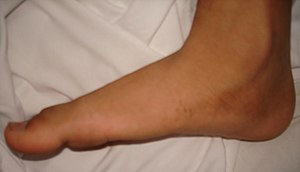Flat feet
| Flat feet | |
|---|---|
 |
|
| A flat foot | |
| Classification and external resources | |
| Specialty | Orthopedics |
| ICD-10 | M21.4, Q66.5 |
| ICD-9-CM | 734 |
| DiseasesDB | 4852 |
| MedlinePlus | 001262 |
| eMedicine | Orthoped/540 |
| MeSH | D005413 |
Flat feet (also called pes planus or fallen arches) is a postural deformity in which the arches of the foot collapse, with the entire sole of the foot coming into complete or near-complete contact with the ground. Some individuals (an estimated 20–30% of the general population) have an arch that simply never develops in one foot (unilaterally) or both feet (bilaterally).
There is a functional relationship between the structure of the arch of the foot and the biomechanics of the lower leg. The arch provides an elastic, springy connection between the forefoot and the hind foot. This association safeguards so that a majority of the forces incurred during weight bearing of the foot can be dissipated before the force reaches the long bones of the leg and thigh.
In pes planus, the head of the talus bone is displaced medially and distal from the navicular. As a result, the spring ligament and the tendon of the tibialis posterior muscle are stretched, so much so that the individual with pes planus loses the function of the medial longitudinal arch (MLA). If the MLA is absent or nonfunctional in both the seated and standing positions, the individual has “rigid” flatfoot. If the MLA is present and functional while the individual is sitting or standing up on their toes, but this arch disappears when assuming a foot-flat stance, the individual has “supple” flatfoot. This latter condition can be correctable with well-fitting arch supports.
Three studies (see citations below in military section) of military recruits have shown no evidence of later increased injury, or foot problems, due to flat feet, in a population of people who reach military service age without prior foot problems. However, these studies cannot be used to judge possible future damage from this condition when diagnosed at younger ages. They also cannot be applied to persons whose flat feet are associated with foot symptoms, or certain symptoms in other parts of the body (such as the leg or back) possibly referable to the foot.
The appearance of flat feet is normal and common in infants, partly due to "baby fat" which masks the developing arch and partly because the arch has not yet fully developed. The human arch develops in infancy and early childhood as part of normal muscle, tendon, ligament and bone growth. Training of the feet, especially by foot gymnastics and going barefoot on varying terrain, can facilitate the formation of arches during childhood, with a developed arch occurring for most by the age of four to six years. Flat arches in children usually become proper arches and high arches while the child progresses through adolescence and into adulthood.
...
Wikipedia
